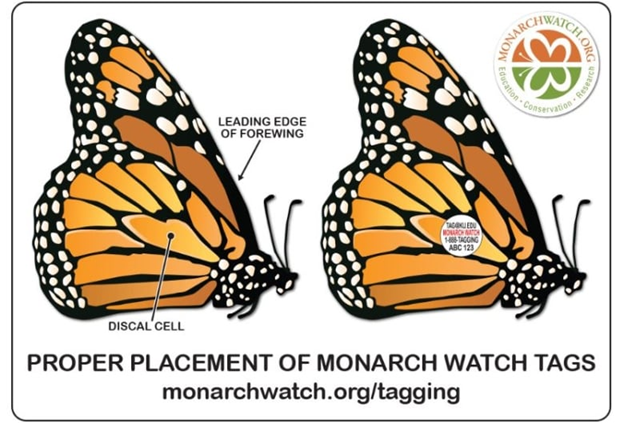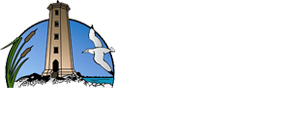
Monarch Watch has updated the monarch tag recovery database for Central Mexico. About 670 tags were purchased by a Monarch Watch representative, who visited the various Mexican communities where monarchs winter in the spring of 2021. Needless to say, the COVID -19 pandemic made this work more challenging!
For Presqu’ile Provincial Park, a wild male released on Sept. 5, 2020 was recovered, and a wild female, released on Sept. 1, 2019 during 34th Monarchs and Migrants Weekend, was also purchased – both at the El Rosario sanctuary. The direct distance from Presqu’ile to El Rosario is about 3429 km. Locals are paid 50 pesos (about $2.52 USD) for each tag turned in. Poverty abounds in the region, and this sum represents a significant addition to household income.
Over the past 20 years, this writer has had monarchs recovered in Mexico every year except for two. Many millions were killed by severe storms in the spring of 2002 in Mexico, and from 2056 monarchs tagged in the fall of 2001, this writer had 43 tagged monarchs recovered, BUT over a span of 5 years. Monarch Watch representatives are unable to meet up each year with everyone who has found monarch tags. The year 2020 represented the 36th consecutive year this writer has tagged monarchs at Presqu’ile, having first tagged monarchs in Colborne in 1967.
History of Monarch Tagging Programs
Former Friends Board member Audrey E. Wilson played critical roles in the creation of Insect Migration Association, founded by late Dr. Fred Urquhart and his wife, Norah. The Urquharts, Audrey Wilson, and Ivy Lemon from Massachusetts Audubon Society met at Presqu’ile in the fall of 1963, and the Insect Migration Association was born. Audrey also produced the IMS Insect Migration Studies newsletter for the first 9 years, with circulation growing from 194 copies to 606 copies. Imagine! In the era before computers! Typing up pages, reproduced on a Gestetner copy machine, compiling the pages, stapling them together and mailing them out to addresses in Canada, the U.S. and elsewhere! And until recent years, Audrey still tagged monarchs!
In 1992, the Urquharts informed this writer that they were winding down their project and were no longer issuing tags. What to do as Monarchs and Migrants Weekend was becoming so popular? Thanks to the generosity of The Friends of Presqu’ile, funding was provided, and this writer arranged for the printing of personal alar tags which read: “Send to Research, Box 1442, Brighton, Ontario, Canada, K0K 1H0.”
The concept of a Monarchs and Migrants Weekend was created by former Park Naturalist Doug McRae in 1985 and was first celebrated in the fall of 1986. For the next 15 years, I worked with Park Naturalist Steve LaForest until David Bree replaced him.
The Monarch Watch program was founded in 1992 by Dr. Orley “Chip” Taylor. Tagging kits are ordered from https://shop.monarchwatch.org/. I soon transitioned to using Monarch Watch tags and being part of this vast citizen science program, but in the meantime, monarchs were recovered in Mexico bearing one of those one-of-a-kind Presqu’ile tags.
Monarch Tagging and Reporting
While tagging monarchs is very easy to learn, one is required under Ontario Fish and Wildlife Conservation Act to apply for a Wildlife Scientific Collectors’ Authorization permit, and to submit a report on activities to MNRF at the end of each tagging season. This link describes laws pertaining to monarchs and other invertebrates: https://www.ontarioinsects.org/laws/
One strategy is to become a member of an organization that has been granted a group permit for rearing and tagging monarchs by MNRF. These include Toronto Entomologists’ Association and Monarch Teacher Network of Canada. Membership in TEA may be free for some students. See: https://www.ontarioinsects.org/membership/ and https://www.ontarioinsects.org/permit/ .
Become a citizen scientist yourself! Report your first sightings of an adult monarch, eggs, caterpillars to a database such as Journey North, eButterfly, Ontario Butterfly Atlas. Restore or create monarch habitat with milkweeds and nectar sources and register this as a Monarch Waystation. There are a number of registered waystations in Ontario. Mission Monarch is a Canadian-based program monitoring monarch reproduction success: https://www.mission-monarch.org/.
“CITIZEN SCIENCE” projects contribute important data which is analyzed by scientists. Needless to say, many young people have developed an interest in nature and the environment through their participation in monarch tagging and conservation-related activities.
As with other outdoor activities, monarch tagging remains a very safe activity during this pandemic. The next generation of monarchs is heading north from the southern United States, and a number of adults and eggs have been spotted in Ohio, where milkweeds have only recently emerged from the ground. I would be most interested in knowing when you spot your first adult monarchs, eggs, and caterpillars. Cell phone or other photos would add to your story.



